TPMS Alfa Romeo 4C 2016 Owner handbook (in English)
[x] Cancel search | Manufacturer: ALFA ROMEO, Model Year: 2016, Model line: 4C, Model: Alfa Romeo 4C 2016Pages: 182, PDF Size: 9.49 MB
Page 16 of 182
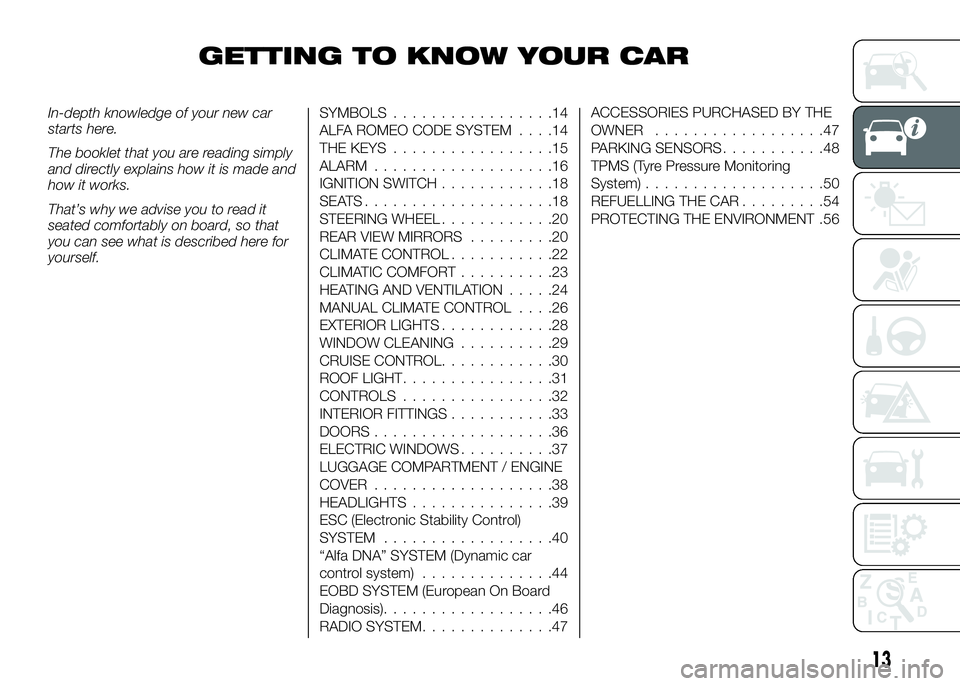
GETTING TO KNOW YOUR CAR
In-depth knowledge of your new car
starts here.
The booklet that you are reading simply
and directly explains how it is made and
how it works.
That’s why we advise you to read it
seated comfortably on board, so that
you can see what is described here for
yourself.SYMBOLS.................14
ALFA ROMEO CODE SYSTEM....14
THE KEYS.................15
ALARM...................16
IGNITION SWITCH............18
SEATS....................18
STEERING WHEEL............20
REAR VIEW MIRRORS.........20
CLIMATE CONTROL...........22
CLIMATIC COMFORT..........23
HEATING AND VENTILATION.....24
MANUAL CLIMATE CONTROL....26
EXTERIOR LIGHTS............28
WINDOW CLEANING..........29
CRUISE CONTROL............30
ROOF LIGHT................31
CONTROLS................32
INTERIOR FITTINGS...........33
DOORS...................36
ELECTRIC WINDOWS..........37
LUGGAGE COMPARTMENT / ENGINE
COVER...................38
HEADLIGHTS...............39
ESC (Electronic Stability Control)
SYSTEM..................40
“Alfa DNA” SYSTEM (Dynamic car
control system)..............44
EOBD SYSTEM (European On Board
Diagnosis)..................46
RADIO SYSTEM..............47ACCESSORIES PURCHASED BY THE
OWNER..................47
PARKING SENSORS...........48
TPMS (Tyre Pressure Monitoring
System)...................50
REFUELLING THE CAR.........54
PROTECTING THE ENVIRONMENT .56
13
Page 53 of 182
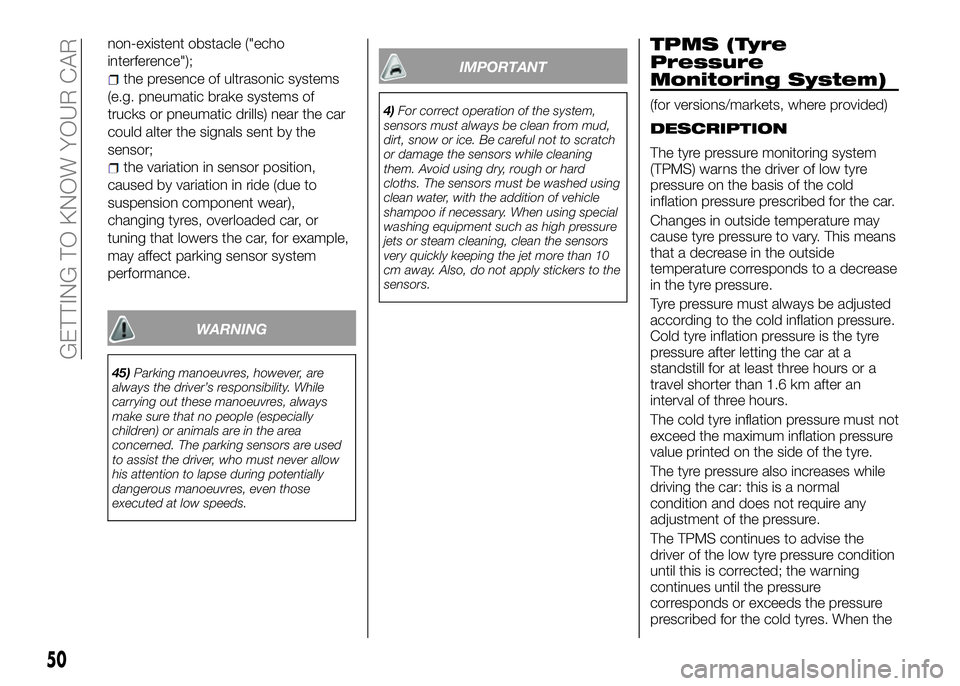
non-existent obstacle ("echo
interference");
the presence of ultrasonic systems
(e.g. pneumatic brake systems of
trucks or pneumatic drills) near the car
could alter the signals sent by the
sensor;
the variation in sensor position,
caused by variation in ride (due to
suspension component wear),
changing tyres, overloaded car, or
tuning that lowers the car, for example,
may affect parking sensor system
performance.
WARNING
45)Parking manoeuvres, however, are
always the driver’s responsibility. While
carrying out these manoeuvres, always
make sure that no people (especially
children) or animals are in the area
concerned. The parking sensors are used
to assist the driver, who must never allow
his attention to lapse during potentially
dangerous manoeuvres, even those
executed at low speeds.
IMPORTANT
4)For correct operation of the system,
sensors must always be clean from mud,
dirt, snow or ice. Be careful not to scratch
or damage the sensors while cleaning
them. Avoid using dry, rough or hard
cloths. The sensors must be washed using
clean water, with the addition of vehicle
shampoo if necessary. When using special
washing equipment such as high pressure
jets or steam cleaning, clean the sensors
very quickly keeping the jet more than 10
cm away. Also, do not apply stickers to the
sensors.
TPMS (Tyre
Pressure
Monitoring System)
(for versions/markets, where provided)
DESCRIPTION
The tyre pressure monitoring system
(TPMS) warns the driver of low tyre
pressure on the basis of the cold
inflation pressure prescribed for the car.
Changes in outside temperature may
cause tyre pressure to vary. This means
that a decrease in the outside
temperature corresponds to a decrease
in the tyre pressure.
Tyre pressure must always be adjusted
according to the cold inflation pressure.
Cold tyre inflation pressure is the tyre
pressure after letting the car at a
standstill for at least three hours or a
travel shorter than 1.6 km after an
interval of three hours.
The cold tyre inflation pressure must not
exceed the maximum inflation pressure
value printed on the side of the tyre.
The tyre pressure also increases while
driving the car: this is a normal
condition and does not require any
adjustment of the pressure.
The TPMS continues to advise the
driver of the low tyre pressure condition
until this is corrected; the warning
continues until the pressure
corresponds or exceeds the pressure
prescribed for the cold tyres. When the
50
GETTING TO KNOW YOUR CAR
Page 54 of 182
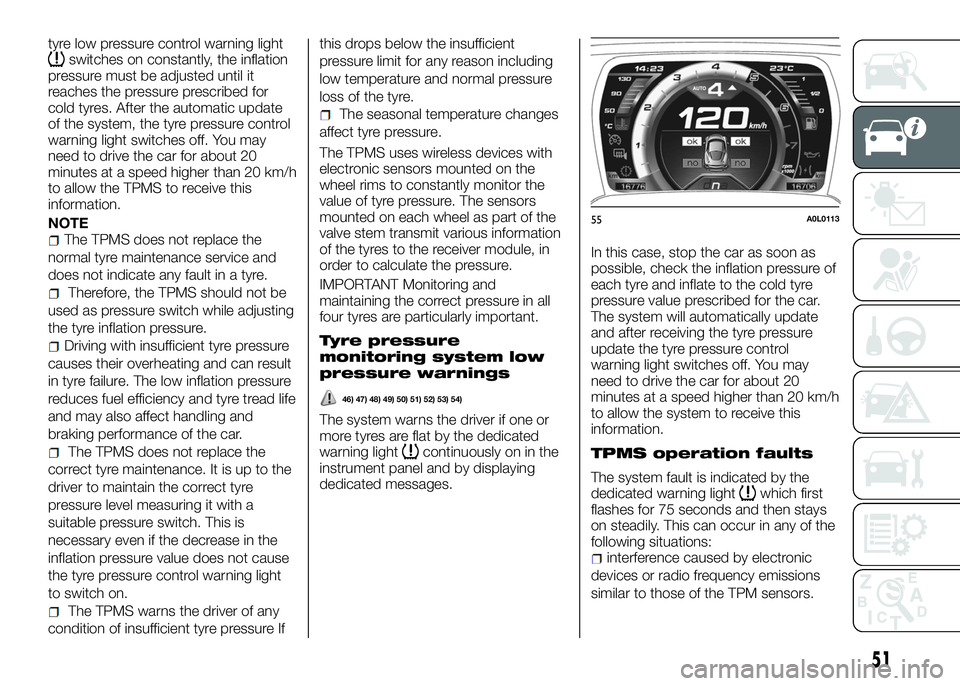
tyre low pressure control warning lightswitches on constantly, the inflation
pressure must be adjusted until it
reaches the pressure prescribed for
cold tyres. After the automatic update
of the system, the tyre pressure control
warning light switches off. You may
need to drive the car for about 20
minutes at a speed higher than 20 km/h
to allow the TPMS to receive this
information.
NOTE
The TPMS does not replace the
normal tyre maintenance service and
does not indicate any fault in a tyre.
Therefore, the TPMS should not be
used as pressure switch while adjusting
the tyre inflation pressure.
Driving with insufficient tyre pressure
causes their overheating and can result
in tyre failure. The low inflation pressure
reduces fuel efficiency and tyre tread life
and may also affect handling and
braking performance of the car.
The TPMS does not replace the
correct tyre maintenance. It is up to the
driver to maintain the correct tyre
pressure level measuring it with a
suitable pressure switch. This is
necessary even if the decrease in the
inflation pressure value does not cause
the tyre pressure control warning light
to switch on.
The TPMS warns the driver of any
condition of insufficient tyre pressure Ifthis drops below the insufficient
pressure limit for any reason including
low temperature and normal pressure
loss of the tyre.
The seasonal temperature changes
affect tyre pressure.
The TPMS uses wireless devices with
electronic sensors mounted on the
wheel rims to constantly monitor the
value of tyre pressure. The sensors
mounted on each wheel as part of the
valve stem transmit various information
of the tyres to the receiver module, in
order to calculate the pressure.
IMPORTANT Monitoring and
maintaining the correct pressure in all
four tyres are particularly important.
Tyre pressure
monitoring system low
pressure warnings
46) 47) 48) 49) 50) 51) 52) 53) 54)
The system warns the driver if one or
more tyres are flat by the dedicated
warning light
continuously on in the
instrument panel and by displaying
dedicated messages.In this case, stop the car as soon as
possible, check the inflation pressure of
each tyre and inflate to the cold tyre
pressure value prescribed for the car.
The system will automatically update
and after receiving the tyre pressure
update the tyre pressure control
warning light switches off. You may
need to drive the car for about 20
minutes at a speed higher than 20 km/h
to allow the system to receive this
information.TPMS operation faults
The system fault is indicated by the
dedicated warning lightwhich first
flashes for 75 seconds and then stays
on steadily. This can occur in any of the
following situations:
interference caused by electronic
devices or radio frequency emissions
similar to those of the TPM sensors.
55A0L0113
51
Page 56 of 182
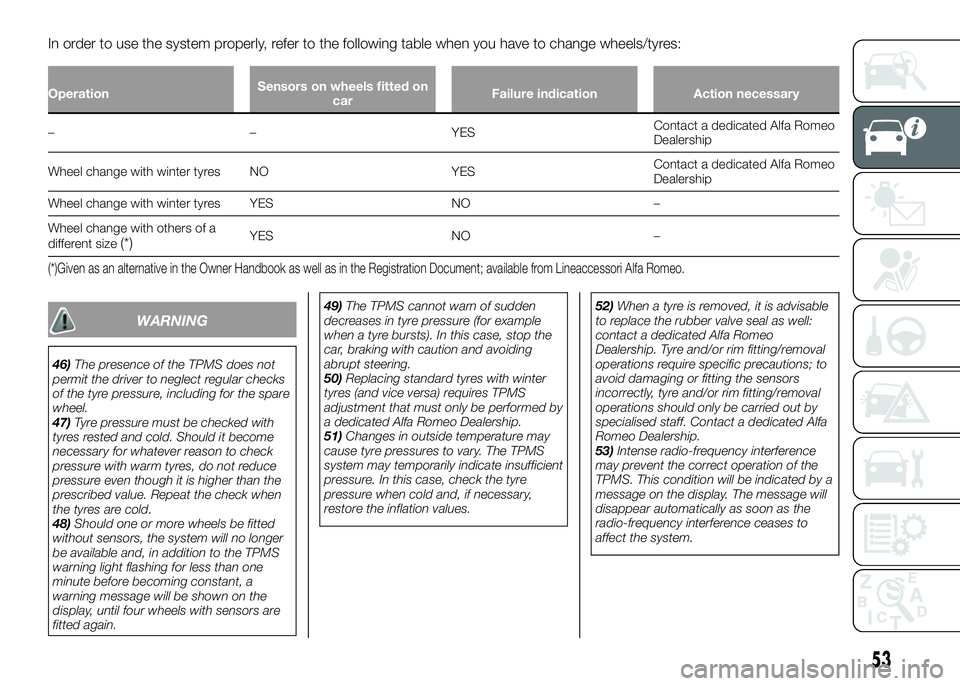
In order to use the system properly, refer to the following table when you have to change wheels/tyres:
OperationSensors on wheels fitted on
carFailure indication Action necessary
– – YESContact a dedicated Alfa Romeo
Dealership
Wheel change with winter tyres NO YESContact a dedicated Alfa Romeo
Dealership
Wheel change with winter tyres YES NO –
Wheel change with others of a
different size
(*)YES NO –
(*)Given as an alternative in the Owner Handbook as well as in the Registration Document; available from Lineaccessori Alfa Romeo.
WARNING
46)The presence of the TPMS does not
permit the driver to neglect regular checks
of the tyre pressure, including for the spare
wheel.
47)Tyre pressure must be checked with
tyres rested and cold. Should it become
necessary for whatever reason to check
pressure with warm tyres, do not reduce
pressure even though it is higher than the
prescribed value. Repeat the check when
the tyres are cold.
48)Should one or more wheels be fitted
without sensors, the system will no longer
be available and, in addition to the TPMS
warning light flashing for less than one
minute before becoming constant, a
warning message will be shown on the
display, until four wheels with sensors are
fitted again.49)The TPMS cannot warn of sudden
decreases in tyre pressure (for example
when a tyre bursts). In this case, stop the
car, braking with caution and avoiding
abrupt steering.
50)Replacing standard tyres with winter
tyres (and vice versa) requires TPMS
adjustment that must only be performed by
a dedicated Alfa Romeo Dealership.
51)Changes in outside temperature may
cause tyre pressures to vary. The TPMS
system may temporarily indicate insufficient
pressure. In this case, check the tyre
pressure when cold and, if necessary,
restore the inflation values.52)When a tyre is removed, it is advisable
to replace the rubber valve seal as well:
contact a dedicated Alfa Romeo
Dealership. Tyre and/or rim fitting/removal
operations require specific precautions; to
avoid damaging or fitting the sensors
incorrectly, tyre and/or rim fitting/removal
operations should only be carried out by
specialised staff. Contact a dedicated Alfa
Romeo Dealership.
53)Intense radio-frequency interference
may prevent the correct operation of the
TPMS. This condition will be indicated by a
message on the display. The message will
disappear automatically as soon as the
radio-frequency interference ceases to
affect the system.
53
Page 57 of 182
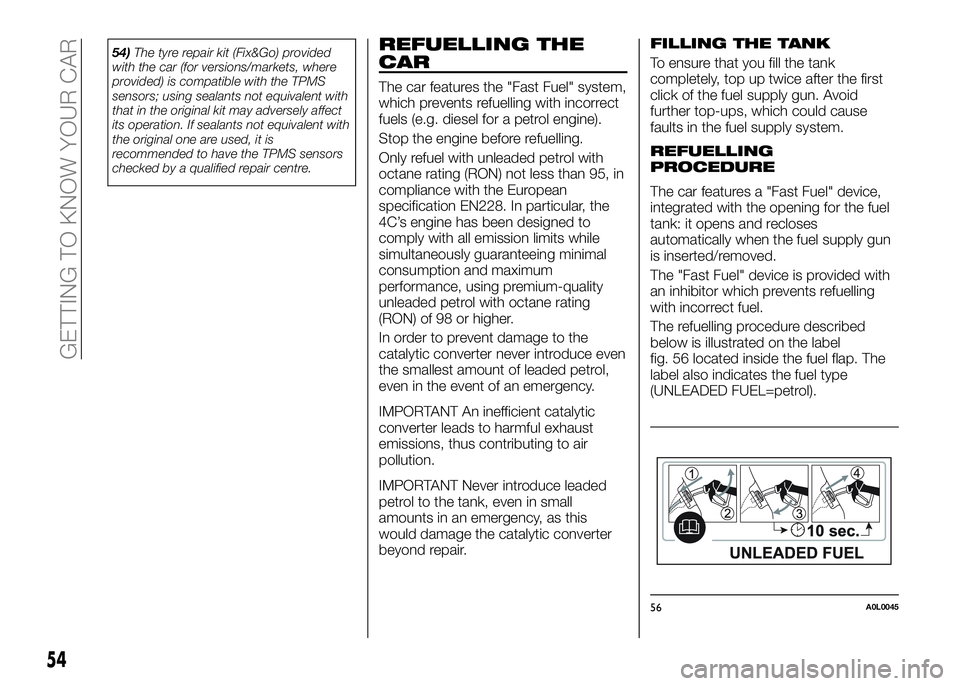
54)The tyre repair kit (Fix&Go) provided
with the car (for versions/markets, where
provided) is compatible with the TPMS
sensors; using sealants not equivalent with
that in the original kit may adversely affect
its operation. If sealants not equivalent with
the original one are used, it is
recommended to have the TPMS sensors
checked by a qualified repair centre.REFUELLING THE
CAR
The car features the "Fast Fuel" system,
which prevents refuelling with incorrect
fuels (e.g. diesel for a petrol engine).
Stop the engine before refuelling.
Only refuel with unleaded petrol with
octane rating (RON) not less than 95, in
compliance with the European
specification EN228. In particular, the
4C’s engine has been designed to
comply with all emission limits while
simultaneously guaranteeing minimal
consumption and maximum
performance, using premium-quality
unleaded petrol with octane rating
(RON) of 98 or higher.
In order to prevent damage to the
catalytic converter never introduce even
the smallest amount of leaded petrol,
even in the event of an emergency.
IMPORTANT An inefficient catalytic
converter leads to harmful exhaust
emissions, thus contributing to air
pollution.
IMPORTANT Never introduce leaded
petrol to the tank, even in small
amounts in an emergency, as this
would damage the catalytic converter
beyond repair.
FILLING THE TANK
To ensure that you fill the tank
completely, top up twice after the first
click of the fuel supply gun. Avoid
further top-ups, which could cause
faults in the fuel supply system.
REFUELLING
PROCEDURE
The car features a "Fast Fuel" device,
integrated with the opening for the fuel
tank: it opens and recloses
automatically when the fuel supply gun
is inserted/removed.
The "Fast Fuel" device is provided with
an inhibitor which prevents refuelling
with incorrect fuel.
The refuelling procedure described
below is illustrated on the label
fig. 56 located inside the fuel flap. The
label also indicates the fuel type
(UNLEADED FUEL=petrol).
56A0L0045
54
GETTING TO KNOW YOUR CAR
Page 74 of 182
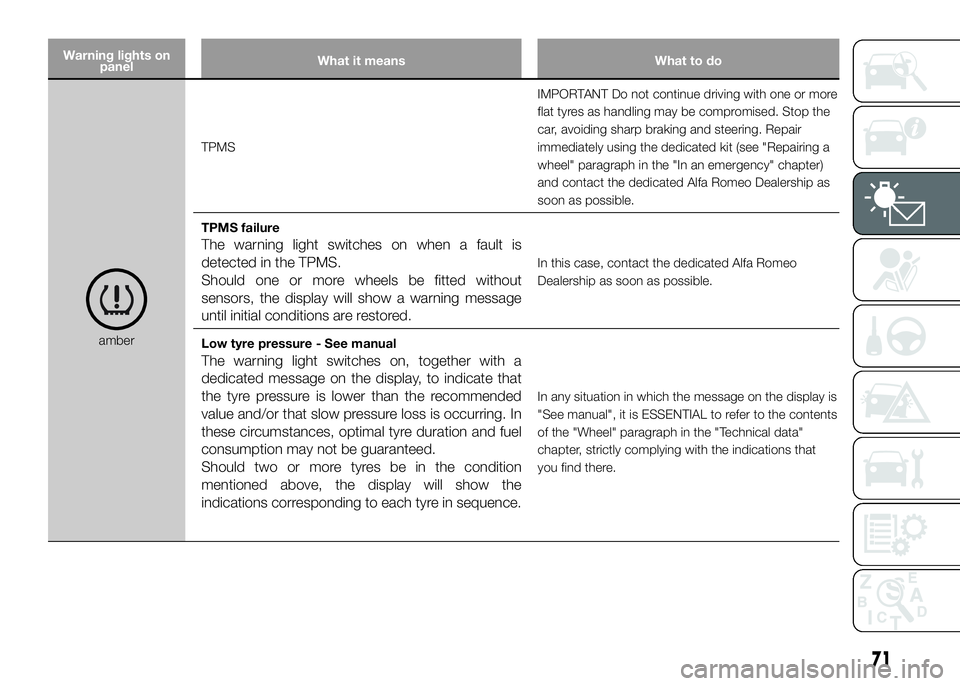
Warning lights on
panelWhat it means What to do
amberTPMSIMPORTANT Do not continue driving with one or more
flat tyres as handling may be compromised. Stop the
car, avoiding sharp braking and steering. Repair
immediately using the dedicated kit (see "Repairing a
wheel" paragraph in the "In an emergency" chapter)
and contact the dedicated Alfa Romeo Dealership as
soon as possible.
TPMS failure
The warning light switches on when a fault is
detected in the TPMS.
Should one or more wheels be fitted without
sensors, the display will show a warning message
until initial conditions are restored.
In this case, contact the dedicated Alfa Romeo
Dealership as soon as possible.
Low tyre pressure - See manual
The warning light switches on, together with a
dedicated message on the display, to indicate that
the tyre pressure is lower than the recommended
value and/or that slow pressure loss is occurring. In
these circumstances, optimal tyre duration and fuel
consumption may not be guaranteed.
Should two or more tyres be in the condition
mentioned above, the display will show the
indications corresponding to each tyre in sequence.
In any situation in which the message on the display is
"See manual", it is ESSENTIAL to refer to the contents
of the "Wheel" paragraph in the "Technical data"
chapter, strictly complying with the indications that
you find there.
71
Page 180 of 182
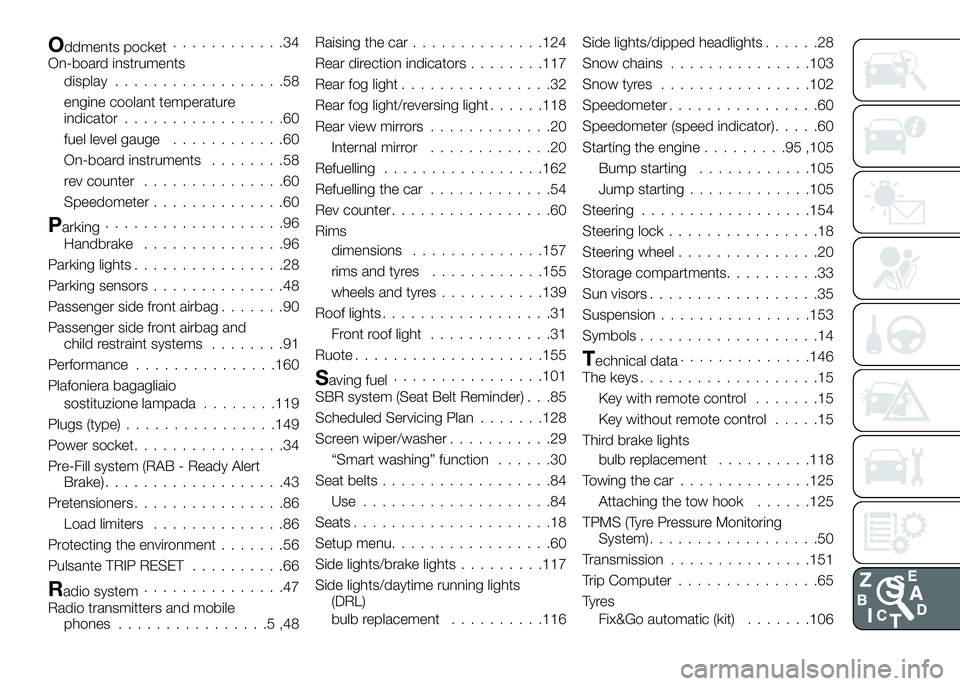
Oddments pocket............34
On-board instruments
display..................58
engine coolant temperature
indicator.................60
fuel level gauge............60
On-board instruments........58
rev counter...............60
Speedometer..............60
Parking...................96
Handbrake...............96
Parking lights................28
Parking sensors..............48
Passenger side front airbag.......90
Passenger side front airbag and
child restraint systems........91
Performance...............160
Plafoniera bagagliaio
sostituzione lampada........119
Plugs (type)................149
Power socket................34
Pre-Fill system (RAB - Ready Alert
Brake)...................43
Pretensioners................86
Load limiters..............86
Protecting the environment.......56
Pulsante TRIP RESET..........66
Radio system...............47
Radio transmitters and mobile
phones................5,48Raising the car..............124
Rear direction indicators........117
Rear fog light................32
Rear fog light/reversing light......118
Rear view mirrors.............20
Internal mirror.............20
Refuelling.................162
Refuelling the car.............54
Rev counter.................60
Rims
dimensions..............157
rims and tyres............155
wheels and tyres...........139
Roof lights..................31
Front roof light.............31
Ruote....................155
Saving fuel................101
SBR system (Seat Belt Reminder) . . .85
Scheduled Servicing Plan.......128
Screen wiper/washer...........29
“Smart washing” function......30
Seat belts..................84
Use ....................84
Seats.....................18
Setup menu.................60
Side lights/brake lights.........117
Side lights/daytime running lights
(DRL)
bulb replacement..........116Side lights/dipped headlights......28
Snow chains...............103
Snow tyres................102
Speedometer................60
Speedometer (speed indicator).....60
Starting the engine.........95,105
Bump starting............105
Jump starting.............105
Steering..................154
Steering lock................18
Steering wheel...............20
Storage compartments..........33
Sun visors..................35
Suspension................153
Symbols...................14
Technical data..............146
The keys...................15
Key with remote control.......15
Key without remote control.....15
Third brake lights
bulb replacement..........118
Towing the car..............125
Attaching the tow hook......125
TPMS (Tyre Pressure Monitoring
System)..................50
Transmission...............151
Trip Computer...............65
Ty r e s
Fix&Go automatic (kit).......106